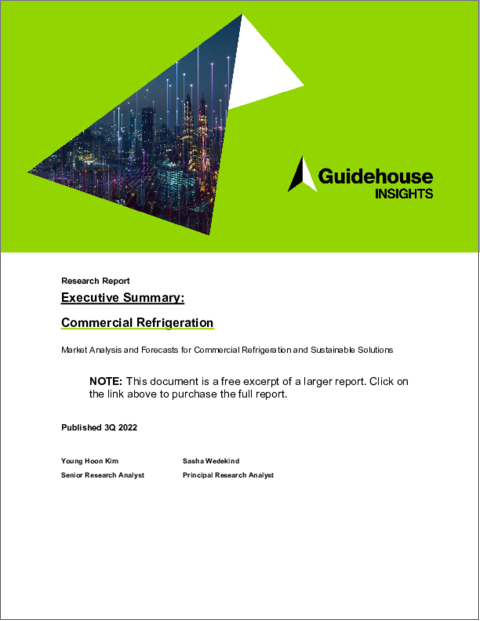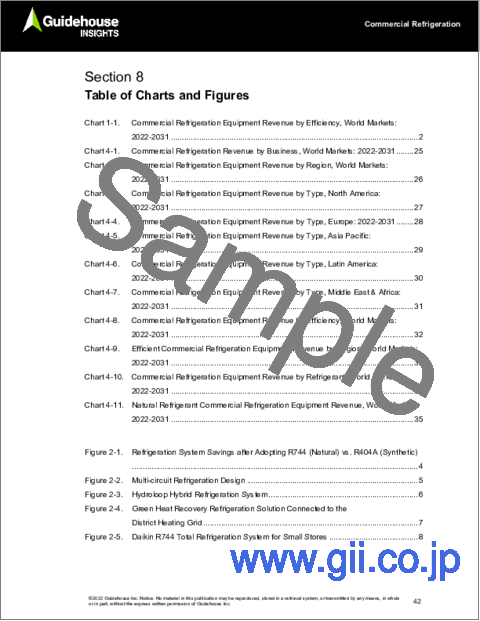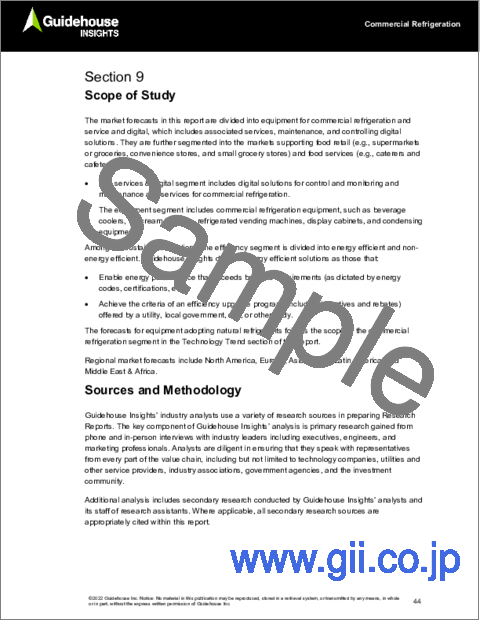|
|
市場調査レポート
商品コード
1109065
業務用冷蔵庫の世界市場:業務用冷蔵庫と持続可能なソリューションの分析と予測Commercial Refrigeration: Market Analysis and Forecasts for Commercial Refrigeration and Sustainable Solutions |
||||||
| 業務用冷蔵庫の世界市場:業務用冷蔵庫と持続可能なソリューションの分析と予測 |
|
出版日: 2022年08月03日
発行: Guidehouse Insights
ページ情報: 英文 47 Pages; 48 Tables, Charts & Figures
納期: 即納可能
|
- 全表示
- 概要
- 図表
- 目次
スーパーマーケットのエネルギーの50%以上を冷蔵が消費しており、高効率化や温室効果ガス排出量の削減を促進するような業務用冷蔵業界における持続可能なソリューションは、市場成長に大きな可能性をもたらすと期待されています。脱炭素化が持続可能な冷蔵市場を牽引しており、そして政策は地球温暖化係数(GWP)の低い冷媒の採用を支援し、高効率システムを奨励しています。
さらに、主要な小売業者は、環境、社会、およびガバナンスに対する責任を示すために、持続可能なソリューションに投資しています。技術の進歩に伴い、資金調達の選択肢が増えたことで、業務用分野における持続可能な冷蔵設備はより手頃なものになると考えられています。
当レポートでは、業務用冷蔵庫市場について調査し、市場動向、促進要因、障壁、市場の概要など包括的な情報を提供しています。
目次
第1章 エグゼクティブサマリー
- イントロダクション
- 市場促進要因と障壁
- 高効率機器の市場概要
第2章 技術動向
- 概要
- 自然冷媒の採用
- 高効率システム設計
- インテリジェント制御
- 技術的問題
- 合成冷媒による健康被害への潜在的脅威
第3章 市場動向
- イントロダクション
- 市場促進要因
- 低GWP冷媒の政策促進要因
- 効率性を向上させるための効率化プログラムと証明書
- ESG
- 技術の進歩
- 資金調達による手頃な価格の向上
- 繁栄する食品業界と小規模店舗需要の増加傾向
- 市場の障壁
- 改善された政策承認の遅れ
- 持続可能な冷凍ソリューションの高いシステムコスト
- 低GWP冷媒の欠点
- 自然冷媒システムの技術者不足
- 持続可能性に対する請負業者の関心の欠如
第4章 市場予測
- 予測調査手法
- 予測範囲
- COVID-19の影響
- 市場概要
- 業務用冷凍機器市場
- 北米
- 欧州
- アジア太平洋
- ラテンアメリカ
- 中東・アフリカ
- 持続可能な業務用冷凍機器市場
- 効率的な業務用冷凍機器
- 自然冷媒の業務用冷凍
第5章 結論と提言
- 政策立案者
- 小売業者
- メーカー
第6章 頭字語と略語のリスト
第7章 目次
第8章 図表
第9章 調査範囲、情報源、調査手法、注記
List of Tables
- Regulation for Limiting GWP and Incentives for Low GWP Refrigerant
- Comparison of Properties of Low GWP Alternative Refrigerants
- Commercial Refrigeration Revenue by Business, World Markets: 2022-2031
- Commercial Refrigeration Revenue by Business, North America: 2022-2031
- Commercial Refrigeration Revenue by Business, Europe: 2022-2031
- Commercial Refrigeration Revenue by Business, Asia Pacific: 2022-2031
- Commercial Refrigeration Revenue by Business, Latin America: 2022-2031
- Commercial Refrigeration Revenue by Business, Middle East & Africa: 2022-2031
- Commercial Refrigeration Equipment Revenue by Region, World Markets: 2022-2031
- Commercial Refrigeration Equipment Revenue by Type, North America: 2022-2031
- Commercial Refrigeration Equipment Revenue by Type, Europe: 2022-2031
- Commercial Refrigeration Equipment Revenue by Type, Asia Pacific: 2022-2031
- Commercial Refrigeration Equipment Revenue by Type, Latin America: 2022-2031
- Commercial Refrigeration Equipment Revenue by Type, Middle East & Africa: 2022-2031
- Commercial Refrigeration Equipment Revenue by Efficiency, World Markets: 2022-2031
- Efficient Commercial Refrigeration Equipment Revenue by Region, World Markets: 2022-2031
- Commercial Refrigeration Equipment Revenue by Efficiency, North America: 2022-2031
- Commercial Refrigeration Equipment Revenue by Efficiency, Europe: 2022-2031
- Commercial Refrigeration Equipment Revenue by Efficiency, Asia Pacific: 2022-2031
- Commercial Refrigeration Equipment Revenue by Efficiency, Latin America: 2022-2031
- Commercial Refrigeration Equipment Revenue by Efficiency, Middle East & Africa: 2022-2031
- Commercial Refrigeration Equipment Revenue by Refrigerant, World Markets: 2022-2031
- Natural Refrigerant Commercial Refrigeration Equipment Revenue by Region, World Markets: 2022-2031
- Commercial Refrigeration Equipment Revenue by Refrigerant, North America: 2022-2031
- Commercial Refrigeration Equipment Revenue by Refrigerant, Europe: 2022-2031
- Commercial Refrigeration Equipment Revenue by Refrigerant, Asia Pacific: 2022-2031
- Commercial Refrigeration Equipment Revenue by Refrigerant, Latin America: 2022-2031
- Commercial Refrigeration Equipment Revenue by Refrigerant, Middle East & Africa: 2022-2031
List of Figures
- Commercial Refrigeration Equipment Revenue by Efficiency, World Markets: 2022-2031
- Commercial Refrigeration Revenue by Business, World Markets: 2022-2031
- Commercial Refrigeration Equipment Revenue by Region, World Markets: 2022-2031
- Commercial Refrigeration Equipment Revenue by Type, North America: 2022-2031
- Commercial Refrigeration Equipment Revenue by Type, Europe: 2022-2031
- Commercial Refrigeration Equipment Revenue by Type, Asia Pacific: 2022-2031
- Commercial Refrigeration Equipment Revenue by Type, Latin America: 2022-2031
- Commercial Refrigeration Equipment Revenue by Type, Middle East & Africa: 2022-2031
- Efficient Commercial Refrigeration Equipment Revenue by Region, World Markets: 2022-2031
- Commercial Refrigeration Equipment Revenue by Refrigerant, World Markets: 2022-2031
- Natural Refrigerant Commercial Refrigeration Equipment Revenue by Region, World Markets: 2022-2031
- Natural Refrigerant Commercial Refrigeration Equipment Revenue, World Markets: 2022-2031
- Refrigeration System Savings after Adopting R744 (Natural) vs. R404A (Synthetic)
- Multi-circuit Refrigeration Design
- Hydroloop Hybrid Refrigeration System
- Green Heat Recovery Refrigeration Solution Connected to the District Heating Grid
- Daikin R744 Total Refrigeration System for Small Stores
- Five-year Moving Average Deposition Fluxes of TFA, PFPrA, and PFBA from Devon Ice Cap (Solid Lines) and Mt. Oxford Icefield (Dashed Lines) Ice Cores
- Refrigerant Safety Classifications
- R744 Commercial Refrigeration in Jakarta, Indonesia, Introduced by Lawson
Global warming is not just a one-industry issue, so collaborating to build teams across industry, government, and finance is essential for achieving decarbonization. Considering that refrigeration consumes more than 50% of supermarket energy, sustainable solutions in the commercial refrigeration industry, such as those promoting high efficiency and reducing greenhouse gas emissions, offer substantial potential for market growth. Decarbonization is driving the sustainable refrigeration market; policies support the adoption of low global warming potential (GWP) refrigerants and programs encourage high efficiency systems. Additionally, major retailers are investing in sustainable solutions to demonstrate environment, social, and governance responsibility. As the technology continues to advance, financing options have made sustainable refrigeration in the commercial sector more affordable.
Although supportive policies are a market driver, a potential delay in the market's transformation is slow approvals for those policies. Also, because sustainable solutions are usually expensive, customers may hesitate to adopt them. In addition, low GWP refrigerants have demonstrated some drawbacks and the lack of technicians and contractors interested in sustainable refrigeration solutions may delay market growth.
This Guidehouse Insights report forecasts the commercial refrigeration market in North America, Europe, Asia Pacific, Latin America, and the Middle East & Africa through 2031. Forecasts are segmented into the equipment used for commercial refrigeration and service and digital, which includes the associated service, maintenance, and controlling digital solutions. Forecast estimates include the market supporting food retail (e.g., supermarkets, convenience stores, and small grocery stores) and food services (e.g., caterers and cafeterias).The equipment forecast also estimates the sustainable refrigeration market for high efficiency and natural refrigerant adoption.
KEY QUESTIONS ADDRESSED:
- What are the market drivers and barriers for the sustainable commercial refrigeration market?
- What are the key technology trends shaping the sustainable commercial refrigeration solutions?
- How is the sustainable commercial refrigeration market expected to grow over the next decade?
- How is revenue in the sustainable commercial refrigeration market expected to differ by region?
- What approach should stakeholders take to exploit opportunities in the sustainable commercial refrigeration market?
WHO NEEDS THIS REPORT:
- Policymakers, city officials, local governments
- National and public standards organizations
- Manufacturers of commercial refrigeration solutions
- Utilities
- Retail players
Table of Contents
1. Executive Summary
- 1.1. Introduction
- 1.2. Market Drivers and Barriers
- 1.3. Market Overview of High-Efficiency Equipment
2. Technology Trends
- 2.1. Overview
- 2.1.1. Natural Refrigerant Adoption
- 2.1.1.1. R744
- 2.1.1.2. HC
- 2.1.1.3. Other Natural Refrigerant Solutions
- 2.1.2. High-Efficiency System Design
- 2.1.2.1. Heat Recovery
- 2.1.2.2. Refrigeration Integrated into Cooling and Heating
- 2.1.3. Intelligent Control
- 2.1.1. Natural Refrigerant Adoption
- 2.2. Technology Issues
- 2.2.1. Potential Health Threats from Synthetic Refrigerants
3. Market Trends
- 3.1. Introduction
- 3.2. Market Drivers
- 3.2.1. Policy Drivers for Low GWP Refrigerants
- 3.2.2. Efficiency Program and Certificates to Improve Efficiency
- 3.2.3. ESG
- 3.2.4. Technology Advances
- 3.2.5. Increased Affordability Through Financing
- 3.2.6. The Thriving Food Industry and the Emerging Trend for Small Store Demand
- 3.3. Market Barriers
- 3.3.1. Slow Approval for Improved Policy
- 3.3.2. High System Cost of Sustainable Refrigeration Solutions
- 3.3.3. Low GWP Refrigerant Drawbacks
- 3.3.3.1. Natural Refrigerants
- 3.3.3.2. Synthetic Refrigerants
- 3.3.4. Technician Shortage for Natural Refrigerant Systems
- 3.3.5. Lack of Contractor Interest in Sustainability
4. Market Forecasts
- 4.1. Forecast Methodology
- 4.2. Forecast Scope
- 4.3. The Effects of COVID-19
- 4.4. Market Overview
- 4.5. Commercial Refrigeration Equipment Market
- 4.5.1. North America
- 4.5.2. Europe
- 4.5.3. Asia Pacific
- 4.5.4. Latin America
- 4.5.5. Latin America
- 4.6. Sustainable Commercial Refrigeration Equipment Market
- 4.6.1. Efficient Commercial Refrigeration Equipment
- 4.6.2. Natural Refrigerant Commercial Refrigeration
5. Conclusions and Recommendations
- 5.1. Policy Makers
- 5.2. Retail Players
- 5.3. Manufacturers




